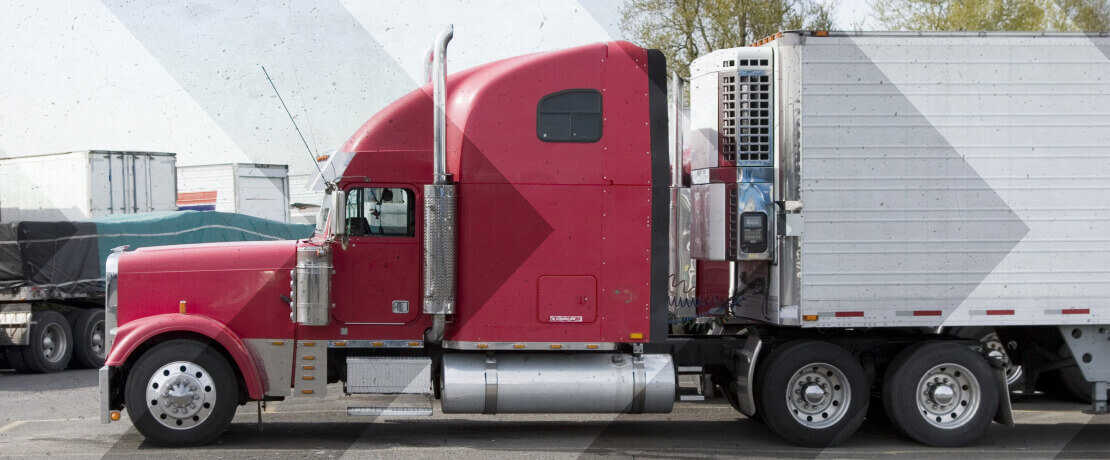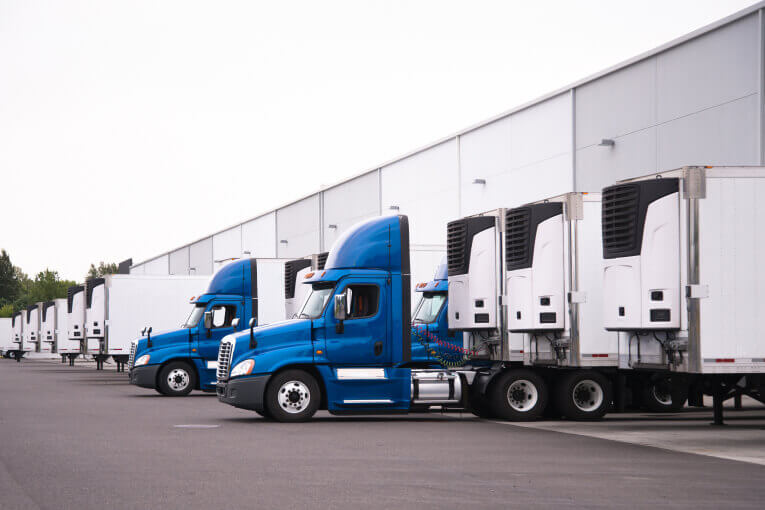Reefer Freight: What It Is, Pros and Cons

Find your next load
Make more money starting now.
If you’ve been around trucking for a little while now, or even if you’re just starting, you’ve heard the term “reefer freight.” Reefer freight is one of the pillars of the trucking industry. A large percentage of the transport trucks running across the highways are reefer trucks.
What is reefer freight?
The “reefer” in reefer freight is an abbreviation of “refrigerated.” If you need to maintain the cargo temperature in transport, you ship it in a reefer truck. Reefer loads come in full or partial trailer loads and less than truckload (LTL) lots.
Most of the time, you’ll find food products, manufacturing chemicals, or pharmaceuticals shipped in temperature controlled conditions. There are three main categories of temperature controlled freight: frozen, refrigerated, or maintained (heated).
Pros and cons of reefer freight
Whether or not reefer freight trucking is the right business for you depends on various factors. Whether you’re a green driver just starting or an established owner-operator looking to expanding your business, consider these pros and cons:
Pros
Lots of work available
Reefer freight is in higher demand and bounces back from economic setbacks faster than other methods of transport. That’s because no matter what crisis impacts the U.S., the demand for food, drink, and medicine rarely subsides. In January 2021, Transport Topics News reported that reefers were among the cargo types that bounced back quickest from the economic impact of the pandemic.
The need for temperature-controlled supplies rolls on through the holidays and is unaffected by the seasons. Reefer drivers benefit from consistent loads week in, week out, and all year around.
Higher prices for cargo
Reefer loads pay better than dry van freight. Goods transported this way often require sensitive temperature control. Most food and beverage companies ship their goods in a refrigerated trailer kept at 32-36°F, like your fridge at home. Most frozen trucks operate at -10°F. Some chemicals and pharmaceutical products require even colder temperatures. The COVID-19 vaccine from Pfizer-BioNtech, for example, requires shipment at -80°C to -60°C (-112°F to -76°F).
In colder weather, reefer trailers also operate as heaters to maintain warmer cargo temperatures during transit. This prevents freezing or other temperature damage for some foods, alcohol, chemicals, and sensitive electronics. Reefer transport is more complex to operate because the loads are sensitive to temperature changes and because it takes specialized equipment to maintain the right temperature.
The types of cargo that require refrigeration are often more valuable than dry freight, impacting the cargo rates shippers are prepared to pay.
Easier pickup and delivery
Grocery chains, distribution centers, and food processing facilities typically have well-organized and well-run loading docks that handle thousands of pounds of cargo daily. The result is easy, stress-free loading and unloading.
Fewer deadhead miles
There are two reasons reefer trucks run fewer deadhead miles.
1. Because there are so many reefer freight loads available, drivers have fewer gaps between loads. More loads mean more load density, so you don’t have to drive far for your next pick-up.
2. Because reefer units don’t have to be reefer units. If you find that refrigerated products are going one way and dry products are going back the other, you can easily turn off the generator and run the trailer dry on the return journey. Reefer trucks generally have the same interior space as dry vans.
Cons
The complexity that makes hauling reefer loads more lucrative also adds challenges to the role. Before you go out on the road with a reefer, you should know the potential downsides:
Pre-cooling requirements and long wait times
Picking up temperature-controlled freight takes longer for a variety of reasons. First, you need to make sure your trailer is at the right temperature before the dock manager at your pickup can load their cargo. They will take the temperature, too. If your yard is close to the pick-up location and you forgot to pre-cool the unit, you’ll be in for a long wait. Groceries often ship on smaller skids or crates and take longer to load as a result. If it’s dangerous (chemicals) or fragile (cases of beer or eggs), it will (and should) take longer to load.
Early to rise, late to rest

You won’t often see a reefer truck pulling up to a dairy or grocery store at midday. Not only does the middle of the day make it harder to keep the cargo cool when you’re unloading, but most shelf-stocking happens after stores have closed. That means early mornings and/or late evenings.
Extra vehicle maintenance
You’re adding a new layer of mechanical complexity to your rig when you add a refrigeration unit. Making sure the cooling unit is in good operating condition, ensuring the oil, Freon, and other fluids are at the right level, even inspecting all the hoses, takes more time and effort. If you don’t maintain the heating and cooling system, you could lose an entire load. Reefer cargo is often messier than dry cargo, so you’ll get well acquainted with the hose and inside of your trailer if you choose these loads.
Extra expenses
You can pay for trailer cleaning, but that’s another cost out of your pocket. In some cases, the shipper will reimburse you, so make sure you keep the cleaning receipts.
Keep the receipt if you pay a lumper too. A lumper is a third-party operator who you pay to unload or load your trailer. You can often negotiate these ahead of time. But if you forget to factor that into your quote, or worse, forget the receipt, you’ll be left holding the bag.
Spoiled freight
“What’s that smell?!” A spoiled load is more than just a pain in the nose for a reefer driver. Cargo that has left the required temperature window because of a breakdown can cost a fortune. Grocery stores will reject freight that has spoiled or is outside the required temperature zone. Sometimes, a business will decline a shipment because the date codes on the products don’t fall within their window. Prevent that from happening by inspecting your cargo at both ends of the journey.
Additional insurance
The good news is, you can buy breakdown coverage. Reefer breakdown insurance is a must-have, but it can be expensive. You’ll also need to keep meticulous maintenance logs to ensure the coverage provider pays up when you need it.
Best practices for transporting reefer freight
Reefer drivers and transport companies can minimize the cons above by following the best practices listed below. Doing so will reduce downtime, increase your reputation among shippers, and help you increase your profit margins.
The best reefer truck operators know to always:
Identify temperature requirements.
Find out ahead of time what the temperature requirements for your load will be. Is it just refrigerated or completely frozen? Do you need to maintain heat? What is the acceptable range? Program your unit ahead of time.
While you’re at it, make sure you know whether or not your cargo is perishable. The business receiving your cargo might only accept products within a certain time frame from their expiry date. That information is usually in the lading instructions. Check your cargo to make sure the receiver will accept the delivery.
Pre-cool your trailer.
Further to the point above, make sure you set your trailer and get it up to operating temperature before you arrive at the pick-up.
Load and unload reefer freight quickly.
This one is a paradox. You have to manage the conflicting needs of fragile cargo and safety with speed and efficiency. The longer your trailer doors are open, the harder it is to maintain temperature. Make sure the dock manager is ready to load your cargo before you open the doors and back up to the dock.
Monitor shipments closely.
Fit your unit with monitoring systems and temperature gauges. You should always know what the temperature is inside your trailer. Redundant monitors add a layer of security and safety. Use the climate monitoring tools before pickup and during shipment to make sure your trailer is always in the right zone.
Keep jumper cables nearby.
The reefer is a separate system from your tractor. It draws its own power from its own set of batteries. If the reefer battery fails, your load is in danger. Running a good quality set of jumper cables from your tractor to your reefer can help save a load until help arrives.
Find high-paying reefer freight.
The best way to find the highest-paying reefer loads is on a quality load board.
You can use the Truckstop Refrigerated Load Board to search for available loads in your area. Because you get detailed information, including destination, load type, and exact miles, you can calculate accurate rates per mile — and even negotiate to improve them. The Truckstop Load Board can show your negotiation strength in any given area by monitoring the truck-to-load ratio. You will see jobs the moment they post online, thanks to the real-time updates.
Sign up today to find reefer truck cargo on Truckstop.
Get helpful content delivered to your inbox.
Sign up today.
Find high-quality loads fast, get higher rates on every haul, and access tools that make your job easier at every turn.






